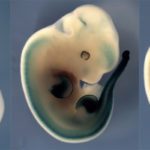Link to Pubmed [PMID] – 24859337
Nat. Genet. 2014 Jul;46(7):753-8
Cleft lip with or without cleft palate (CL/P) is one of the most common congenital malformations observed in humans, with 1 occurrence in every 500-1,000 births. A 640-kb noncoding interval at 8q24 has been associated with increased risk of non-syndromic CL/P in humans, but the genes and pathways involved in this genetic susceptibility have remained elusive. Using a large series of rearrangements engineered over the syntenic mouse region, we show that this interval contains very remote cis-acting enhancers that control Myc expression in the developing face. Deletion of this interval leads to mild alteration of facial morphology in mice and, sporadically, to CL/P. At the molecular level, we identify misexpression of several downstream genes, highlighting combined impact on the craniofacial developmental network and the general metabolic capacity of cells contributing to the future upper lip. This dual molecular etiology may account for the prominent influence of variants in the 8q24 region on human facial dysmorphologies.

